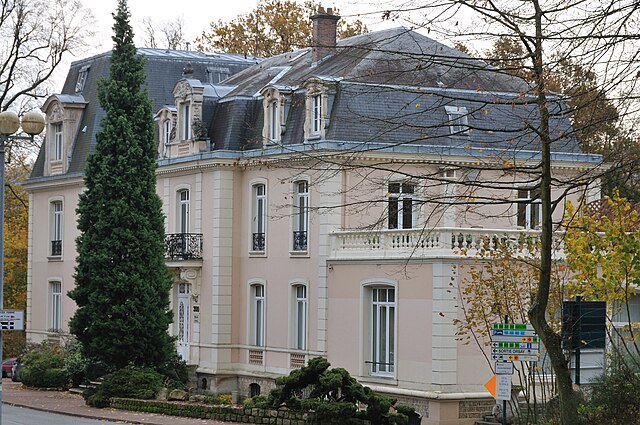Top Qs
Timeline
Chat
Perspective
Paris-Sud University
Former university in Paris, France From Wikipedia, the free encyclopedia
Remove ads
Paris-Sud University (French: Université Paris-Sud), also known as the University of Paris — XI (or as the Orsay Faculty of Sciences, University of Paris before 1971), was a French research university distributed among several campuses in the southern suburbs of Paris, including Orsay, Cachan, Châtenay-Malabry, Sceaux, and Kremlin-Bicêtre campuses. In 2019, the university was replaced by the Paris-Saclay University.[1]

Remove ads
History
Summarize
Perspective
Paris-Sud, as the Orsay Faculty of Sciences, was originally part of the University of Paris, which was subsequently split into several universities. After World War II, the rapid growth of nuclear physics and chemistry meant that research needed more and more powerful accelerators, which required large areas. The University of Paris, the École normale supérieure and the Collège de France looked for space in the south of Paris near Orsay. Later some of the teaching activity of the Faculty of Sciences in Paris was transferred to Orsay in 1956 at the request of Irène Joliot-Curie and Frédéric Joliot-Curie. The rapid increase of students led to the independence of the Orsay Campus on 1 March 1965 (sometimes called "Faculté des sciences d'Orsay" thereafter). The institution became the "University of Paris-Sud (Paris XI)" in 1971.
Paris-Sud hosted a great number of laboratories on its large (236 ha) campus. Many of the top French laboratories were among them especially in particle physics,[2] nuclear physics,[3][4] astrophysics,[5] atomic physics and molecular physics,[6] condensed matter physics,[7] theoretical physics,[8] electronics, nanoscience and nanotechnology.[9] University of Paris-Sud comprised some 104 research units.
Pierre-Gilles de Gennes and Albert Fert, two Nobel Prize winners of physics, were affiliated to the University of Paris-Sud. A number of the most renowned French mathematicians were affiliated with the University of Paris-Sud as well. Among them are the Fields medalists Pierre Deligne, Laurent Lafforgue, Jean-Christophe Yoccoz, Wendelin Werner and Ngô Bảo Châu.
Paris-Sud also comprised biology and chemistry laboratories, engineering and technology schools and had established partnerships with many of the surrounding technology centres and Grandes Ecoles. It also included Schools of Law, Economics and Management.
In 2019, University Paris–Sud was replaced by the University of Paris-Saclay.[1]
Remove ads
Notable people
Fields Medal
- Pierre Deligne (Fields Medal, 1978)
- Jean-Christophe Yoccoz (Fields Medal, 1994)
- Laurent Lafforgue (Fields Medal, 2002)
- Wendelin Werner (Fields Medal, 2006)
- Ngô Bảo Châu (Fields Medal, 2010)
Nobel Prize
- Pierre-Gilles de Gennes (Nobel Prize in physics, 1991)
- Albert Fert (Nobel Prize in physics, 2007)
- Alain Aspect (Nobel Prize in Physics, 2022)
Others
- Aristides Baltas, philosopher of science, physicist, and former Minister of Culture and Sports of Greece, as well as Minister of Education and Religious Affairs
- Katarina Barley, German politician and lawyer, current Federal Minister of Justice and Consumer Protection in the fourth Cabinet of Angela Merkel
- Agnès Barthélémy, physicist, expert on nanostructures
- Étienne-Émile Baulieu, chemist
- Louis-Marie de Blignières, Traditionalist Catholic priest
- Charles Édouard Bouée, CEO of Roland Berger Consulting
- Olivier Bohuon, Chief Executive of Smith & Nephew plc
- Marielle Chartier, physicist
- Jean-Louis Colliot-Thélène, French mathematician
- Monique Combescure, French mathematical physicist
- Michel Davier, physicist
- Adrien Douady, mathematician
- Cornelia Druțu, Romanian mathematician, professor of mathematics at the University of Oxford
- Anne Dambricourt-Malassé, paleoanthropologist
- Jean-Marc Fontaine, mathematician
- Erol Gelenbe, Professor Univ. Paris-Sud (1979-1986), Computer Scientist, Fellow of the French Academy of Technologies, the Royal Academy of Science, Letters and Fine Arts of Belgium, The Science Academy Society of Turkey and other academies, Mustafa Prize 2017.
- Jean Ginibre, mathematician
- Kawtar Hafidi, physicist
- Henri B. Kagan, chemist, winner of the Wolf Prize in Chemistry (2001)
- André Lagarrigue, physicist
- Serge Latouche, economist
- Jean-Yves Le Gall, President of National Centre for Space Studies (CNES)
- Carlos Moreno, urbanist, academic and author
- André Neveu, physicist
- Véronique Newland, CEO, New Vision Technologies
- François Olivennes, physician and fertility specialist
- Siamak Mohammadi, professor of electrical and computer engineering at the University of Tehran
- Bernadette Perrin-Riou, mathematician and recipient of the Satter Prize[10]
- Bertrand Serlet, former Senior Vice President of Software Engineering at Apple Inc.
- François Baccelli, mathematician and engineer
Remove ads
Rankings
- Paris-Sud was ranked 1st in France, 9th in Europe and 37th worldwide by the 2019 Academic Ranking of World Universities (ARWU).[15] (5th in Mathematics, 9th in Physics worldwide).
- In October 2015, The University of Paris Sud has been ranked 10th best university worldwide in the Times Higher Education Under 50[16] which is a ranking of the world top 100 universities under 50 years old.
- QS Ranking has ranked the University 262nd in the world, 97th in Natural Science, 101-150th in Medicine and 285th in Engineering and Technology.[17]
Points of interest
See also
Wikimedia Commons has media related to University of Paris-Sud.
References
External links
Wikiwand - on
Seamless Wikipedia browsing. On steroids.
Remove ads


